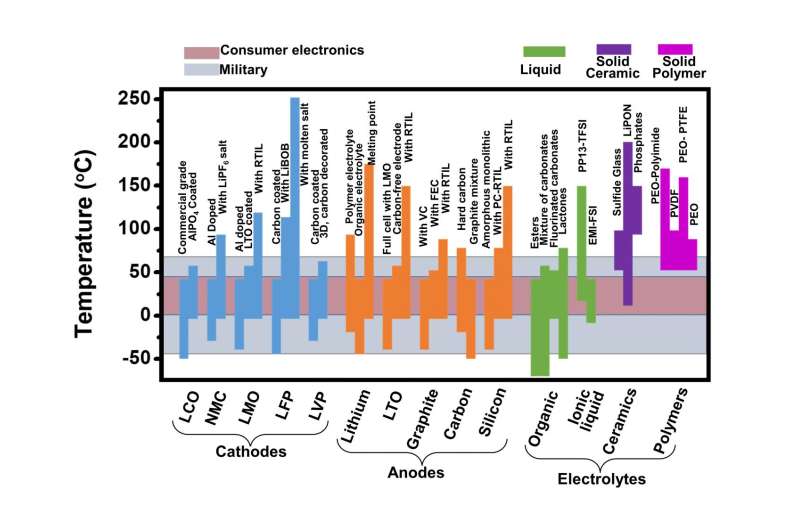Scientists map ways forward for lithium-ion batteries for extreme environments

Lithium-ion batteries are popular power sources for cellphones and other electronics, but problematic in extreme heat or cold. A Rice University laboratory has suggested ways to extend their range.
Rice materials scientist Pulickel Ajayan and members of his lab have published a review that analyzes recent progress in lithium-ion technology and suggests how to make the batteries more adaptable for challenging conditions. The work reviewed includes some of Ajayan and his team's own pioneering efforts to extend the capabilities of lithium-ion, the portable power storage of choice for consumer electronics, military applications, electric cars and more.
The review appears this week in Nature Energy.
Negative news about lithium-ion batteries in recent years has revolved around combusting cellphones and smoking aircraft batteries. But more common issues like the desire for batteries that last longer and charge more quickly are the prime drivers of research.
"We searched hard to find one paper that talks about all the problems at the same time and what all the individual components experience at extreme temperatures, and we couldn't find one," said Hemtej Gullapalli, a postdoctoral researcher at Rice and co-author of the paper. "So we believe this is a good opportunity to survey the field."
The Rice team was most interested in seeing how batteries perform in temperatures from minus 60 to 150 degrees Celsius (minus 76 to 302 degrees Fahrenheit), knowing that current batteries are designed to operate near room temperature and within a narrow temperature range. At best, lithium-ion batteries lean toward either hot or cold operations, which is less than optimal for an electric car driven from the hot desert to snowy peaks.
"People have not looked that studiously at temperature constraints," Gullapalli said. He noted how frustrating it can be when a phone shuts down in the cold or heat and said charging a phone also raises the temperature inside a battery—which is why a phone should never be left recharging in a hot car.
"Most research involving batteries and temperatures involve management systems: For instance, if a phone is used in cold temperatures, they slow it down a little bit to preserve the battery," he said. "But we found in our review that the perspective is changing slightly. To make batteries that work from low to high temperatures, scientists have to take the materials perspective to see what temperature is specifically doing to the materials."
Electrochemical batteries have three basic components: A negative anode, a positive cathode and a conducting electrolyte that allows electrons to move from one side to the other, while either charging or draining. The materials in each offer opportunities, Gullapalli said.
"People have done amazing work," he said. "They've touched almost the whole periodic table and all the permutations and combinations have been tested. Now we're into the engineering phase where we know the materials' limitations and we are trying to break down the barriers."
The Rice team built a comprehensive map of both standard and promising new materials in commercial batteries and detailed their typical energy densities and temperature ranges for each component.
"We compared stabilities of materials with respect to each other and against a temperature scale," Ajayan said. "This will help researchers cherry-pick a required combination for their needs."
Performance in current lithium-ion batteries requires compromise, the researchers wrote. For example, water-based electrolytes like lead-acid and nickel-metal hydride operate only between minus 50 and 50 C, while molten salt batteries work fine only at temperatures above 90 C. Batteries with lithium thionyl chloride operate between minus 60 and 150 C, but only at peak between 20 and 55 C.
"Building an ideal or a close-to-ideal system requires a thorough understanding of the subtle mechanisms and replacing each delinquent component with a suitable alternative," Ajayan said. "A trivial component at ambient conditions can change the whole electrochemistry when exposed to high temperatures."
More information: Marco-Tulio F. Rodrigues et al, A materials perspective on Li-ion batteries at extreme temperatures, Nature Energy (2017). DOI: 10.1038/nenergy.2017.108

















